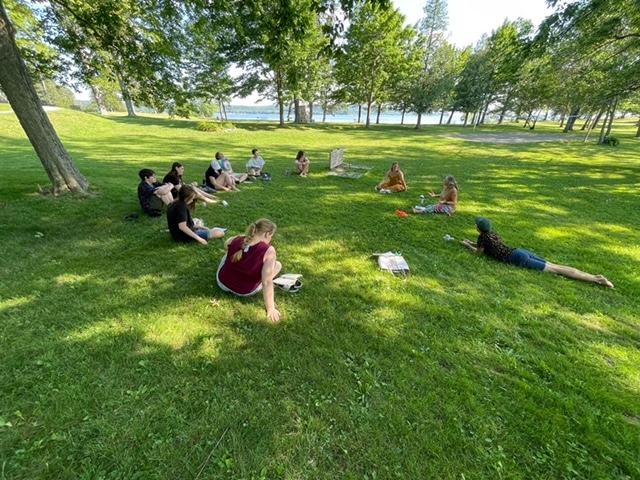“Celebrating Indigenous Poetry of New England” – The Sundog Justice and Poetry Event
BFA students participate in a writing workshop with poet Suzanne Rancourt. Photo credit: Larissa Hebert
August 4, 2022
On July 22, for the first time since 2019, the Sundog Poetry organization was able to host their annual “Justice and Poetry for All” event at Kill Kare State Park.
The “Justice and Poetry” event, first held in 2018, was originally a bit different than this year’s program, according to Sundog Poetry board member, William Drislane, who is also their treasurer.
“The board members who had created and developed the series had since left the organization. So it was like ‘jump ball!’ We were trying to recreate the form of the earlier programs, but the information was difficult to come by,” Drislane said.
According to Drislane, after some guidance from Cheryl Savageau, a popular New England poet of Abenaki descent, Sundog was steered in the direction of Indigenous cultures.
“And that is where we landed: Celebrating Indigenous Poetry of New England,” Drislane said.
This was also the first time Bellows Free Academy students were able to attend. Larissa Hebert, a Bellows Free Academy English teacher, brought a group of students to the event as a summer Academy Breakout field trip.
Hebert said she has worked with Sundog Poetry since 2015 to organize and implement their “Share Your Heart, Share the World” poetry event for Vermont students, which Hebert has brought her classes to. When Hebert heard about BFA’s summer programming, she realized Sundog’s “Justice and Poetry” event would be a great enrichment opportunity for students.
Hebert said she also helped Sundog Poetry with the event, contributing to planning, advertising and organizing catering through The Clean Spoon.
According to Hebert, from 3:30 – 8:30 p.m., BFA students partook in the event, as well as a poetry workshop with Suzanne Rancourt, another popular Indigenous poet. Rancourt walked students through some movements and breathing exercises, meant to help them connect with nature, and gave a short explanation of creative cultures from an Indigenous perspective. Students then spread out across the park for a 7-minute solo writing exercise. After that, students were given the opportunity to share their writings.
One of the poems shared, written by August Hawkins (‘23), reads:
Is my spot the best one I could find?
Did I find the shadiest tree, the softest grass?
Is there somewhere I would like more?
Maybe I should spend the rest of my time
Making sure there’s nowhere better.
There was then about an hour of free time between the workshop and actual reading, which students used to relax, enjoy a snack and add to their poems.
At 6:00 p.m., the full event began. In addition to BFA students, community members gathered under the Kill Kare pavilion for the highlight of the evening: an Indigenous poetry reading.
According to Drislane, “We were very fortunate to connect with people from the Missisquoi nation community and the other Vermont tribes — Morgan Lamphere, Charlie Delaney Megeso, Chief Richard Menard and his granddaughter Chantel Menard-Bockus. Their presence made the day a success.”
According to the evening’s program, the reading began with Rancourt reciting her poetry. This was followed by a variety of Indigenous poetry, by writers such as Carol Dana, Robert Peters and Alice Azure, being read by Menard-Bockus, Lamphere and Sundog board members.
The readings were accompanied by personal anecdotes, cultural music (courtesy of Lamphere), a land blessing by Chief Menard and Menard-Bockus and a description of Indigenous lives in New England.
Hebert said that she was happy with how the reading went.
“I was very pleased by the public turnout for the event,” Hebert said. “I found the reading enjoyable and Morgan Lamphere’s music was a nice touch.”
According to BFA students, “Justice and Poetry” was a great experience.
“I wasn’t expecting to be this interested in poetry, but it was really cool,” Tanner Dalley (‘23) said.
Drislane also said he viewed the day as a success.
“The show was a marvelous opening into the world of the Abenaki and the other Wabanaki tribes of the ‘dawnland’ — it was like a door opening for the audience to see the history of these peoples through the writings and poetry,” Drislane said.

